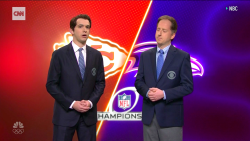Editor’s Note: Bill Carter, a media analyst for CNN, covered the television industry for The New York Times for 25 years, and has written four books on TV, including The Late Shift and The War for Late Night. The opinions expressed in this commentary are his own.

Over the last couple of weekends, I have been able to feed my hunger for sports diversion by watching golf tournaments and occasional matches of Premier League soccer.
Both, of course, had no fans in attendance.
Every great golf shot was met with complete silence, except for an occasional howl of surprise from an announcer. Meanwhile, in the soccer matches, not only were goals punctuated by the usual explosions of crowd exultation, but every promising run down the pitch had a rise in fan anticipation, and every missed opportunity the predictable moans of disappointment.
All of these were manufactured — canned, as it were — in an audio studio. The pre-recorded crowd noise was set up to accompany the developing action of the live game, strictly for the home TV viewers. In the stadium, the players, coaches and whoever else happened to be around heard none of that.
I thought I would find the faked crowd noise distracting or annoying. But I didn’t mind it. On occasion it seemed mildly out of place — a player being penalized would usually attract more vociferous outrage.
The golf approach did feel more natural (there’s a lot of quiet in golf), though when something spectacular happened — like sinking a 50-foot putt in a playoff — the absence of a burst of cheering was noticeable.
Overall, the faux fans in soccer functioned like background music in a movie scene: there, but not front of mind — which is good because it looks like we are in for more of this new experience as more sports start airing on television again.
The big American sports leagues — Major League Baseball, the National Basketball Association and maybe college and pro football down the road — are moving to re-open their seasons. Baseball will finally get to the cry of “play ball,” this week.
That they will all do it without fans in the stands underscores that the vast majority of income generated by sports leagues comes from TV deals. At the same time, the decision by soccer leagues to juice up their telecasts with canned cheering proves those leagues believe live audiences add something essential.
American sports leagues are leaning the same way. Reports indicate that they have all been talking about options for fabricated crowd sounds. On CNN last month, the celebrated announcer, and now CNN contributor, Bob Costas, made a prediction: “One network or another and maybe all of them, if it catches on, will experiment with the idea of piping in crowd sound.”
So we should prepare ourselves.
Maybe a lot of viewers have been getting ready without even realizing it. My dive back into sports reminded me of how I have felt in recent months watching a different kind of audience-influenced entertainment: late-night TV.
Sure, the look of the shows is different; and the sound is drastically changed without live audiences. But my expectations are modest; and I’m still being entertained. I know nobody is there in the host’s rec room to supply the laughs, but the product is still good. It doesn’t need a hokey laugh track (or cheer track). And I admire the hosts for getting on with it without trying to sell me on the idea that everything is normal.
No one could have guessed it would work out this well. These shows are built around comedy, after all. Comics sing in the shower; they don’t tell jokes in the shower. They do not know they’re funny. Somebody has to tell them — by laughing.
Seth Meyers, star of NBC’s “Late Night” show, told me in an email that he has been affected, somewhat, by being in an ultra-quiet environment (his attic):
“My natural performance style is fast-talking,” he wrote. “And with no audience to slow me down it’s like driving the Autobahn with no speed limits.”
Generally, when a comic doesn’t hear laughter, he or she tries something else or looks for the exit. But that hasn’t happened to Meyers or Stephen Colbert or Jimmy Kimmel or Sam Bee or any of the big late-night TV hosts. They’ve done shows in what amounts to a laugh vacuum: no hint if a joke is working; no way to tell how long to pause between lines to let the laugh play out.
“I miss how every audience is unique and therefore affects the show a different way,” Meyers wrote to me. “Some nights they are red hot and you get to ride on that for the full hour or they can be so cold that you have to use every weapon in your arsenal to fight your way through it. I don’t just miss the good audiences. I miss the bad ones, too.”
Crowd-muted sports might not work out as well — for some natural reasons: Sports on TV would seem weird in eerie silence; while, in contrast, a late-night host can keep amiably mocking the news and talking to appealing guests to ensure there’s no dead air.
People expect a steady crowd hum or murmur when they watch live sports. Late-night shows have no similar constant buzz; audiences are often silently attentive, so it’s not disconcerting to watch them now.
Canned cheering can work in sports (they did it routinely in the early days of radio when baseball games were “re-created” in studios) because viewers know when fans would spring into vocal action during a game; their reactions are predictable, so the falseness of manufactured emotion goes by without notice. By contrast, nobody knows which joke will inspire reaction, so hearing no laughs isn’t entirely unexpected. But canned laughter at a joke that should have bombed would be jarringly false.
It helps that the late-night shows have been consistently creative — and honest — in how they have approached their situation. What the country is going through is weird; why shouldn’t late-night shows be a little weird, too?
Meyers said he has received a few complaints from fans who miss the laugh gaps:
“I admit I get people online complaining I talk too fast for them to understand. This is an actual tweet: Slow down, man! It’s like there’s a clock ticking down to when the attic oxygen will run out.”
But see, that’s probably a sports fan talking: Unlike a football game, when you’re home watching late-night on TV, you don’t yell at the screen and call for a time out.



























